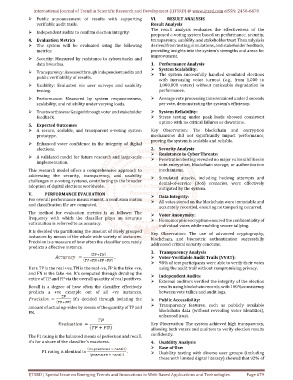Page 689 - Emerging Trends and Innovations in Web-Based Applications and Technologies
P. 689
International Journal of Trend in Scientific Research and Development (IJTSRD) @ www.ijtsrd.com eISSN: 2456-6470
Public announcement of results with supporting VI. RESULT ANALYSIS
verifiable audit trails. Result Analysis
The result analysis evaluates the effectiveness of the
Independent audits to confirm election integrity.
proposed e-voting system based on performance, security,
4. Evaluation Metrics transparency, usability, and stakeholder trust. The analysis is
The system will be evaluated using the following derived from testing, simulations, and stakeholder feedback,
metrics: providing insights into the system’s strengths and areas for
improvement.
Security: Measured by resistance to cyberattacks and
data breaches. 1. Performance Analysis
System Scalability:
Transparency: Assessed through independent audits and
The system successfully handled simulated elections
public verifiability of results.
with increasing voter turnout (e.g., from 1,000 to
Usability: Evaluated via user surveys and usability 1,000,000 voters) without noticeable degradation in
testing. performance.
Performance: Measured by system responsiveness, Average vote processing time remained under 2 seconds
scalability, and reliability under varying loads. per vote, demonstrating the system’s efficiency.
Trustworthiness: Gauged through voter and stakeholder System Reliability:
feedback. Stress testing under peak loads showed consistent
uptime with no critical failures or downtime.
5. Expected Outcomes
A secure, scalable, and transparent e-voting system Key Observation: The blockchain and encryption
prototype. mechanisms did not significantly impact performance,
proving the system is scalable and reliable.
Enhanced voter confidence in the integrity of digital
elections. 2. Security Analysis
Resistance to Cyber Threats:
A validated model for future research and large-scale
Penetration testing revealed no major vulnerabilities in
implementation.
vote encryption, blockchain storage, or authentication
This research model offers a comprehensive approach to mechanisms.
addressing the security, transparency, and usability Simulated attacks, including hacking attempts and
challenges in e-voting systems, contributing to the broader denial-of-service (DoS) scenarios, were effectively
adoption of digital elections worldwide.
mitigated by the system.
V. PERFORMANCE EVALUATION
For overall performance measurement, a confusion matrix Data Integrity:
All votes stored on the blockchain were immutable and
and classification file are computed.
accurately recorded, ensuring no tampering occurred.
The method for evaluation metrics is as follows: The
Voter Anonymity:
frequency with which the classifier plays an accurate
Homomorphic encryption ensured the confidentiality of
vaticination is referred to as accuracy.
individual votes while enabling secure tallying.
It is decided via partitioning the amount of nicely grouped Key Observation: The use of advanced cryptography,
instances by means of the whole wide variety of instances.
blockchain, and biometric authentication successfully
Precision is a measure of how often the classifier accurately
addressed critical security concerns.
predicts a effective instance.
3. Transparency Analysis
, Voter-Verifiable Audit Trails (VVAT):
98% of test participants were able to verify their votes
Here TP is the real +ve, TN is the real -ve, FP is the fake +ve, using the audit trail without compromising privacy.
and FN is the fake -ve. It's computed through dividing the Independent Audits:
entire of TP and FP via the overall quantity of real positives.
External auditors verified the integrity of the election
Recall is a degree of how often the classifier effectively results using blockchain records, with 100% consistency
predicts a +ve example out of all +ve instances. between vote tallies and audit logs.
It's decided through isolating the Public Accessibility:
Transparency features, such as publicly available
amount of actual up-sides by means of the quantity of TP and
FN. blockchain data (without revealing voter identities),
enhanced trust.
Key Observation: The system achieved high transparency,
allowing both voters and auditors to verify election results
confidently.
The F1 rating is the balanced means of perfection and recall.
it's for a share of the classifier's exactness. 4. Usability Analysis
Ease of Use:
F1 rating is identical to . Usability testing with diverse user groups (including
those with limited digital literacy) showed that 92% of
IJTSRD | Special Issue on Emerging Trends and Innovations in Web-Based Applications and Technologies Page 679

